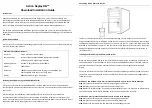
24
Manual: Cool-Ceramic Safety Herschel Prism Mark II
Tips for photographic observation
Although the sun is bright enough, you cannot zoom in as high as you like. The achie-
vable resolution is limited by three factors:
Air turbulence:
it often limits the resolution to about one second of arc. Higher
resolutions can only be achieved by "lucky imaging", i.e. by stacking numerous short-
exposure images that practically freeze the air turbulence. For long-exposure deep-
sky images, aim for an image scale of about one arcsecond per pixel; for the sun and
planets, you can try up to 0.1-0.3" per pixel.
The resolving power of your telescope:
Already with telescopes around 125 to 150
mm aperture you will reach the resolution of about one arc second which can be used
for longer exposure times with good seeing. Larger telescopes offer the necessary
reserves for moments with excellent seeing, or for use at very good locations, or espe-
cially for lucky imaging – that is, filming the sun and then stacking the best shots.
The pixel size of the camera,
which must match the resolution of the telescope and
the image scale. For this purpose, the focal length is adapted to the pixel size of the
camera by means of a high-quality Barlow lens. As a rule of thumb, an image scale of
about half the resolution of the telescope should be aimed for. For a 20-cm telescope
with a resolution of 0.6", this means a scale of about 0.3"/pixel; for a 10-cm telescope
with 1.3" resolution, this results in about 0.6"/pixel.
The resolution in arc seconds per pixel is calculated from
resolution [arcsec] = (pixel size / focal length) × 206,265
The resolution of a telescope in seconds of arc at a wavelength of 540 nm is obtai-
ned as follows
resolution [arcsec] = 1,22 ×
...
0,000 000 540 mm
..
× 360×3600
telescope aperture [mm]
2π
For best results, we also recommend using the Solar Continuum with a monochrome
camera on apochromats. It is also advisable to take flats with the sun to compensate
for dust in the system/on the sensor. This can be done, for example, with a semi-trans-
parent film in front of the lens; use it to capture a piece of the sky away from the sun.



































